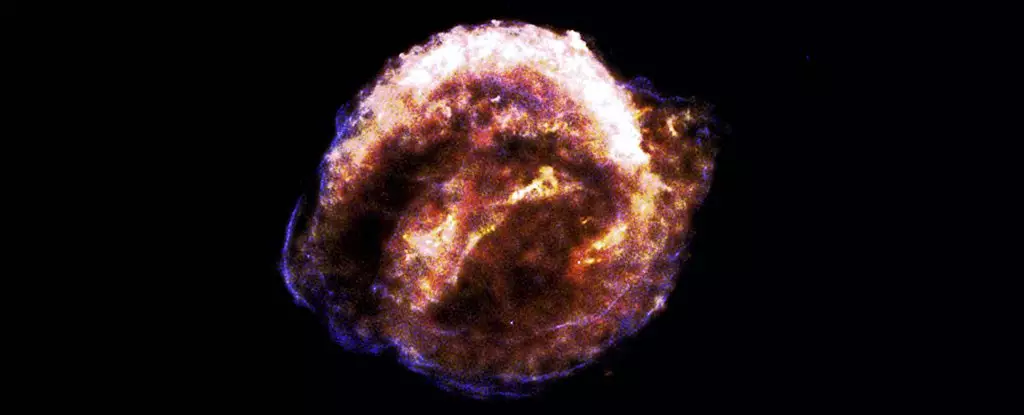Supernovae are among the most spectacular events in the universe, marking the explosive death of massive stars. Beyond their breathtaking beauty, these cosmic upheavals are fundamental to the very fabric of our existence. When a massive star exhausts its nuclear fuel, it culminates in a cataclysmic explosion, releasing an incredible amount of energy and matter into the cosmos. This process is not merely a spectacular light show; it plays a pivotal role in the formation of heavy elements, such as iron, that are crucial for the development of life on planets like Earth.
The significance of supernovae extends to the preservation of key isotopes in geological records. Notably, scientists have identified accumulations of the iron isotope Fe60 in seafloor sediments, dating back several million years. These remnants allow researchers to trace cosmic events and their potential impact on our planet. Recent studies, as outlined in the Astrophysical Journal Letters, have delved into how these supernovae might have influenced both the physical environment and the biological evolution on Earth.
Cosmic radiation, a constant flux of high-energy particles from beyond our atmosphere, plays a vital role in life on Earth. While terrestrial radiation has gradually diminished over geological time, cosmic radiation is inextricably linked to Earth’s position within the Milky Way. The movement of our Solar System through the galaxy exposes us to varying levels of this radiation, which fluctuates based on nearby cosmic events, notably supernovae.
Research led by Caitlyn Nojiri from UC Santa Cruz explores how these stellar explosions elevated radiation levels on Earth, potentially reshaping the evolutionary trajectory of life. The findings suggest that the higher radiation levels resulting from supernova blasts may not only influence the mutation rates of DNA but also encourage diversification among species. Consequently, understanding the implications of supernovae on Earth’s primordial environment should be a focal point for evolutionary biologists.
One fascinating aspect of this research is the concept of the Local Bubble, a vast cavity in the interstellar medium where our Solar System currently resides. This bubble, approximately 1,000 light-years in diameter, is the product of multiple supernova explosions over millions of years. The interplay between these explosions and the surrounding cosmic environment has created an area that may have been instrumental in shaping life’s evolution on Earth.
The historical analysis indicates our Solar System entered the Local Bubble around five to six million years ago, coinciding with the accumulation of Fe60 residues found in sediment samples. A subsequent accumulation approximately two to three million years ago potentially emerged from more recent supernovae events in nearby stellar associations. This reinforces the notion that our cosmic neighborhood continues to play a crucial role in the evolution of the life forms populating our planet.
The energy released during supernovae, while providing essential elements for life, also carries risks. The ions produced in these cosmic events can generate high levels of ionizing radiation, capable of causing significant biological damage. Research implies these radiation bursts might create double-strand breaks in DNA, leading to mutations that could either benefit or harm future generations.
The possibility that increased mutation rates might spur greater biological diversification raises intriguing questions. Could the cosmic radiation associated with supernovae have been a catalyst in species diversification during pivotal evolutionary moments? For instance, studies suggest that certain aquatic microorganisms exhibited heightened diversification rates during the same periods identified with increased cosmic radiation. While a direct causal link remains to be definitively established, the correlations are tantalizing.
Despite the exciting findings, significant gaps in our understanding persist. The exact relationship between cosmic radiation and evolutionary processes requires further research to delineate. The authors of the recent study highlight the need for more in-depth investigations into how cosmic radiation impacts life, including the role that specific particles, like muons, play in the biological effects we observe.
The overarching question remains: at what point does radiation become a beneficial influence on evolution, and when does it turn harmful? Amidst this uncertainty, one fact stands clear: the ongoing relationship between Earth and the cosmos is a dynamic one that continues to shape the living world.
Supernovae serve as critical players in the cosmic theater of life, providing the building blocks while simultaneously introducing destructive forces. The radiation emitted from these celestial events may have acted as a driving force behind significant evolutionary milestones on Earth. As we continue to decipher the complexities of how cosmic factors influence life on our planet, we come to appreciate the intricate interconnections that define our existence.
Perhaps without the cataclysmic remnants of ancient stars, Earth’s biosphere would look drastically different today. Acknowledging our cosmic lineage invites us to reflect on the vast forces at play in the universe, emphasizing that life’s story is profoundly intertwined with the phenomena beyond our direct perception.


Leave a Reply